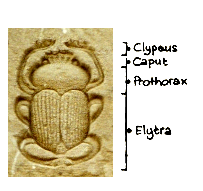
Term used to refer to a beetle common in Egypt, 'scarabaeus sacer', called 'kheper 'by the Egyptians, a word that also means 'to become'. This animal, who lays its eggs in a ball of dung, was regarded by the Egyptians as the personification of spontaneous life springing out of the earth. This was associated with the sun being reborn from the earth, Khepry, often depicted as a beetle or as a man with a beetle as a head. The way the beetle pushed the dung ball along was seen as a parallel of the way the sun disk crossed the sky. Representations of scarabs were used as amulets as early as the Old Kingdom. They were originally uninscribed, but from the Middle Kingdom on they were used as seals with the flat underside being carved with decorative motifs or texts. Many texts on scarabs contain the name of a king, but as it was common to choose the name of a famous king from the distant past, dating is often problematic. Amenhotep III of the 18th Dynasty had a large number of scarabs made with texts recording important events such as his marriage to Queen Tiy, a lion hunt or the construction of a lake. A special type of scarab is the so-called heart scarab, an amulet that was often shaped like a scarab on one side and a heart on the other. This object was placed between the mummy bandages or hung around the neck on a chain and was meant to prevent the heart testifying against the deceased during the final judgement. It was usually inscribed with a text from the Book of the Dead, calling on the heart not to testify against its owner. There was also another type of funerary scarab, often made of faience and sometimes with outspread wings, separately made. They were placed on the chest of the deceased and attached to the mummy net.